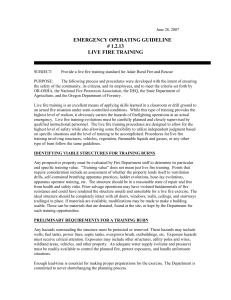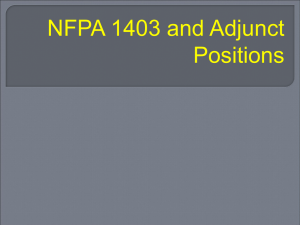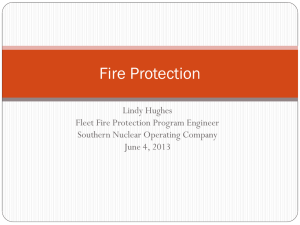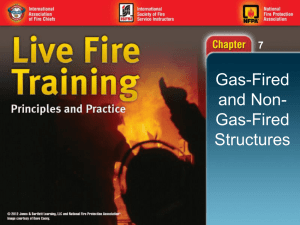Chapter 6 Non–Gas-Fired Training Center Buildings
advertisement
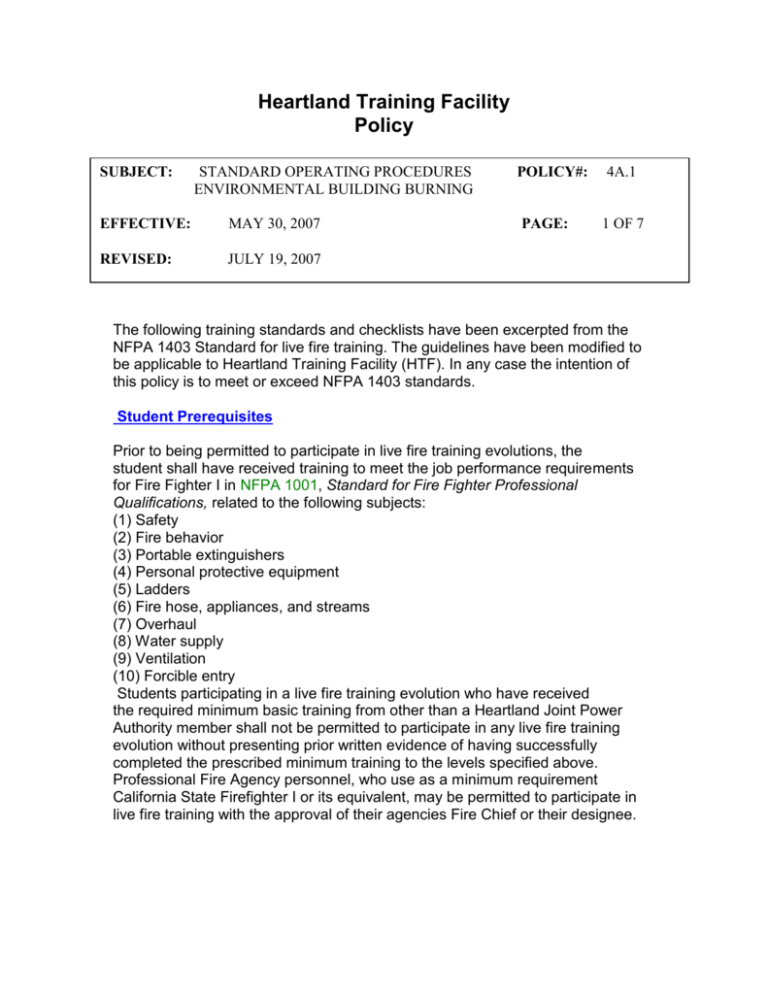
Heartland Training Facility Policy SUBJECT: STANDARD OPERATING PROCEDURES ENVIRONMENTAL BUILDING BURNING EFFECTIVE: MAY 30, 2007 REVISED: JULY 19, 2007 POLICY#: PAGE: 4A.1 1 OF 7 The following training standards and checklists have been excerpted from the NFPA 1403 Standard for live fire training. The guidelines have been modified to be applicable to Heartland Training Facility (HTF). In any case the intention of this policy is to meet or exceed NFPA 1403 standards. Student Prerequisites Prior to being permitted to participate in live fire training evolutions, the student shall have received training to meet the job performance requirements for Fire Fighter I in NFPA 1001, Standard for Fire Fighter Professional Qualifications, related to the following subjects: (1) Safety (2) Fire behavior (3) Portable extinguishers (4) Personal protective equipment (5) Ladders (6) Fire hose, appliances, and streams (7) Overhaul (8) Water supply (9) Ventilation (10) Forcible entry Students participating in a live fire training evolution who have received the required minimum basic training from other than a Heartland Joint Power Authority member shall not be permitted to participate in any live fire training evolution without presenting prior written evidence of having successfully completed the prescribed minimum training to the levels specified above. Professional Fire Agency personnel, who use as a minimum requirement California State Firefighter I or its equivalent, may be permitted to participate in live fire training with the approval of their agencies Fire Chief or their designee. 1-1 Structures and Facilities 1-1.1 Strict safety practices shall be applied to all structures selected for live fire training evolutions. 1-1.2 Training center burn buildings shall be inspected visually for damage prior to live fire-training evolutions. 1-1.3 Damage shall be documented. 1-1.4 The structural integrity of the building shall be evaluated and documented annually by a licensed professional engineer with burn building experience and expertise. 1-1.5 Part of the burn building evaluation shall include, once every five years, the removal and reinstallation of a representative area of thermal linings (if any) to inspect the hidden conditions behind the linings. 1-1.6 The engineer shall core solid structural concrete slabs and walls that have been exposed to temperatures in excess of 149°C (300°F) to check for hidden delaminations and to test compressive strength once every 10 years for conventional (Portland) concrete and every three years for refractory (calcium aluminate) concrete. 1-1.7 Where the burn building damage is severe enough to affect the safety of the students, training shall not be permitted. 1-1.8 All doors, windows and window shutters, roof scuttles and automatic ventilators, mechanical equipment, lighting, manual or automatic sprinklers, and standpipes necessary for the live fire training evolution shall be checked and operated prior to any live fire training evolution to ensure they operate correctly. 1-1.8.1 Training center burn buildings shall be left in a safe condition upon completion of live fire training evolutions. 1-1.9 Debris hindering the access or egress of fire fighters shall be removed prior to the beginning of the next training exercises. 1-1.10 In preparation for live fire training, an inspection of the structure shall be made to determine that the floors, walls, stairs, and other structural components are capable of withstanding the weight of contents, participants, and accumulated water. 1-1.11 Property adjacent to the training site that could be affected by the smoke from the live fire training evolution, such as railroads, airports or heliports, and nursing homes, hospitals, or other similar facilities, shall be identified. 1-1.12 The persons in charge of the properties described in 1-1.10 shall be informed of the date and time of the evolution. 1-1.13 Streets or highways in the vicinity of the training site shall be surveyed for potential effects from live fire-training evolutions, and safeguards shall be taken to eliminate any possible hazard to motorists. 1-1.14 Pedestrian traffic in the vicinity of the training site shall be kept clear of the operations area of the live burn by the use of fire lines, fences, gates, or personnel. 1-1.15Awareness of weather conditions, wind velocity, and wind direction shall be maintained, including a final check for possible changes in weather conditions immediately before actual ignition. 1-1.16 The water supply for any individual live fire training evolution shall be assessed and based on the extent of the evolutions to be performed. 1-1.17 Consideration shall be given to the control and extinguishments of the fire and the provision of necessary backup lines to protect personnel. 1-1.18 The minimum water supply and delivery for live fire training evolutions shall meet the criteria identified in NFPA 1142, Standard on Water Supplies for Suburban and Rural Fire Fighting. 1-1.19 A minimum reserve of additional water in the amount of 50 percent of the fire flow demand determined in accordance with 1-1.18 shall be available to handle exposure protection or unforeseen situations. 1-1.20 Separate sources shall be utilized for the supply of attack lines and backup lines in order to preclude the loss of both water supply sources at the same time. RIC personnel shall be assigned and have no other duties than rescue. They shall have a charged hose line with sufficient water flow for fire attack and an independent water source. Exception: A single source shall be sufficient at a training center facility where the water system has been engineered to provide adequate volume for the evolutions conducted and a backup power source or backup pumps, or both, are in place to ensure an uninterrupted supply in the event of a power failure or malfunction. 1-1.21 Areas for the staging, operating, and parking shall be designated for fire apparatus that are to be used during the live fire training. 1-1.22 An area for parking fire apparatus and vehicles that are not a part of the evolution shall be designated so as not to interfere with fireground operations. 1-1.23 Consideration shall be given to locating this area in order to facilitate prompt response of apparatus in the event of an emergency. 1-1.24 Where required or necessary, parking areas for police vehicles, the media, or other observers shall be designated. 1-1.25 A parking area for an ambulance or emergency medical services vehicles shall be designated. 1-1.26 Consideration shall be given to locating this area to facilitate prompt response in the event of a personal injury to participants in the evolution. 1-1.27 Consideration shall be given to the designation and layout of ingress/egress routes in order to ensure their availability in the event of an emergency. 1-1.28 Prior to conducting actual live fire-training evolutions, a preburn briefing session shall be conducted for all participants. 1-1.29 All facets of each evolution to be conducted shall be discussed in the preburn briefing, and assignments shall be made for all crews participating in the training session. 1-1.30 The location of simulated victims shall not be required to be disclosed, provided that the possibility of victims is discussed during the preburn briefing. Personnel shall not be used as victims. 1-1.31 A preburn plan shall be prepared and shall be utilized during the preburn briefing sessions. 1-1.32 All features of the training areas and structure shall be indicated on the preburn plan. 1-1.33 Prior to conducting any live fire training, all participants shall be required to conduct a walk-through of the structure in order to have a knowledge of and familiarity with the layout of the building and to facilitate any necessary evacuation of the building. 1-1.34 All spectators shall be restricted to an area outside the operations area perimeter established by the Safety Officer. 1-1.35 Control measures such as road cones, ropes, signs, fire line tape, shall be positioned to indicate the perimeter of the operations area. 1-1.36 Visitors who are allowed within the operations area perimeter to observe operations shall be escorted at all times. 1-1.37 Visitors who are allowed within the operations area perimeter shall be equipped with and shall wear complete protective clothing according to manufacturer's instructions and in accordance with 1-3.21 through 1-3.27 . 1-1.38 All possible sources of ignition, other than those that are under the direct supervision of the person responsible for the start of the training fire, shall be removed from the operations area. 1-2 Fuel Materials 1-2.1 The fuels that are utilized in live fire training evolutions shall have known burning characteristics that are as controllable as possible. 1-2.2 Unidentified materials, such as debris found in or around the structure that could burn in unanticipated ways, react violently, or create environmental or health hazards shall not be permitted to be used. 1-2.3 Fuel loading at HTF shall not exceed the equivalent volume of two wood pallets and a ¼ bale of straw at any given time. Furniture, cushions, and other furnishings are not to be utilized when burning at HTF. 1-2.4 Pressure-treated wood, rubber, plastic, and straw or hay treated with pesticides or harmful chemicals, shall not be permitted to be used. 1-2.5 The fuel load shall be limited to avoid conditions that could cause an uncontrolled flashover or backdraft. 1-2.6 The use of flammable or combustible liquids, as defined in NFPA 30, Flammable and Combustible Liquids Code, shall not be permitted to be used in live fire-training evolutions in structures. 1-2.7 The instructor-in-charge shall assess the selected fire room environment for factors that can affect the growth, development, and spread of the fire. 1-2.8 The instructor-in-charge shall document fuel loading including all of the following: (1) Furnishings (2) Wall and floor coverings and ceiling materials (3) Type of construction of the structure, including type of roof and combustible void spaces (4) Dimensions of rooms 1-2.9 The training exercise shall be stopped immediately should the instructor-incharge determine through ongoing assessment that the combustible nature of the environment represents a potential hazard. The instructor-in-charge shall continuously monitor conditions throughout the duration of each evolution. 1-2.10 In the event an evolution has been stopped for safety reasons, the evolution shall continue only when actions have been taken to reduce the hazard. 1-3 Safety 1-3.1 A safety officer shall be appointed for all live fire training evolutions. 1-3.2 The safety officer shall have the authority, regardless of rank, to intervene and control any aspect of the operations when, in his or her judgment, a potential or actual danger, accident, or unsafe condition exists. 1.3.3 The responsibilities of the safety officer shall include, but shall not be limited to, the following: (1) Prevention of unsafe acts (2) Elimination of unsafe conditions 1-3.4 The safety officer shall provide for the safety of all persons on the scene including students, instructors, visitors, and spectators. 1-3.5 The safety officer shall not be assigned other duties that interfere with safety responsibilities. 1-3.6 The safety officer shall be knowledgeable in the operation and location of safety features available within and around the burn building, such as RIC personnel location, ventilation scuttles, door and window openings, water sources, additional personnel for rescue, and evacuation alarms. 1-3.7 The instructor-in-charge of the live fire training evolutions shall determine, prior to each specific evolution, the number of training attack lines and backup lines that are necessary. 1-3.8 Backup lines shall be provided to ensure protection for personnel on training attack lines. 1-3.9 Each hoseline shall be capable of delivering a minimum of 95 GPM. 1-3.10 The instructor-in-charge shall assign the following personnel: (1) One instructor to each functional crew, which shall not exceed five students (2) One instructor to each backup line (3) Additional personnel to backup lines to provide mobility (4) One additional instructor for each additional functional assignment (5) RIC personnel (6) One instructor to the position of ignition officer (7) Ventilation personnel 1-3.11 Additional safety personnel, as deemed necessary by the safety officer, shall be located strategically within the structure to react to any unplanned or threatening situation or condition. 1-3.12 A method of fireground communications shall be established to enable coordination among the incident commander, the interior and exterior sectors, the safety officer, and external requests for assistance. 1-3.13 A building evacuation plan shall be established, including an evacuation signal to be demonstrated to all participants in an interior live fire training evolution. 1-3.14 Emergency medical services shall be available on site to handle injuries. 1-3.15 Written reports shall be filled out and submitted on all injuries and on all medical aid rendered. An investigation per HTF policy shall be conducted on all injuries. 1-3.16 A search of the structure shall be conducted to ensure that no unauthorized persons, animals, or objects are in the building immediately prior to ignition. 1-3.17 No person(s) shall play the role of a victim inside the building. 1-3.18 Fires shall not be located in any designated exit paths. 1-3.19 The training session shall be curtailed, postponed, or canceled, as necessary, to reduce the risk of injury or illness caused by extreme weather conditions. 1-3.20 Each participant shall be equipped with full protective clothing and selfcontained breathing apparatus (SCBA). 1-3.21 All participants shall be inspected by the safety officer prior to entry into a live fire training evolution to ensure that the protective clothing and SCBA are being worn according to manufacturer's instruction and are in serviceable condition. 1-3.22 Protective coats, trousers, hoods, footwear, helmets, and gloves shall have been manufactured to meet the requirements of NFPA 1971, Standard on Protective Ensemble for Structural Fire Fighting. 1-3.23 Self-contained breathing apparatus (SCBA) shall have been manufactured to meet the requirements of NFPA 1981, Standard on OpenCircuit Self-Contained Breathing Apparatus for the Fire Service. 1-3.24 Where station or work uniforms are worn by any participant, the station or work uniform shall have been manufactured to meet the requirements of NFPA 1975, Standard on Station/Work Uniforms for Fire and Emergency Services. 1-3.25 Personal alarm devices shall have been manufactured to meet the requirements of NFPA 1982, Standard on Personal Alert Safety Systems (PASS). 1-3.26 All students, instructors, safety personnel, and other personnel shall wear all protective clothing and equipment specified in this chapter according to manufacturer's instructions whenever they are involved in any evolution or fire suppression operation during the live fire training evolution. 1-3.27 All students, instructors, safety personnel, and other personnel participating in any evolution or operation of fire suppression during the live fire training evolution shall breathe from an SCBA air supply whenever operating under one or more of the following conditions: (1) In an atmosphere that is oxygen deficient or contaminated by products of combustion, or both (2) In an atmosphere that is suspected of being oxygen deficient or contaminated by products of combustion, or both (3) In any atmosphere that can become oxygen deficient or contaminated, or both (4) Below ground level 1-3.28 One person who is not a student shall be designated as the “ignition officer” to control the materials being burned. 1-3.29 The ignition officer shall wear full protective clothing, including selfcontained breathing apparatus (SCBA), as required in 1-3.21 through 1-3.27, when performing this control function. 1-3.30 A charged hose line shall accompany the ignition officer when he or she is igniting any fire. 1-3.31 The decision to ignite the training fire shall be made by the instructor-incharge in coordination with the safety officer. 1-3.32 The fire shall be ignited by the ignition officer in the presence of and under the direct supervision of the safety officer. 1-4 Instructors 1-4.1 The instructor-in-charge shall be the rank of Captain or above and shall possess a CA State Fire Control 3 certificate to deliver fire fighter training according to the authority having jurisdiction. 1-4.2 The participating student-to-instructor ratio shall not be greater than 5 to 1. 1-4.3 Additional instructors shall be designated when factors such as extreme temperatures or large groups are present, and classes of long duration are planned. 1-4.4 The instructor-in-charge shall be responsible for full compliance with this standard. 1-4.5 Prior to the ignition of any fire, instructors shall ensure that all protective clothing and equipment specified in this chapter are being worn according to manufacturer instructions. 1-4.6 Instructors shall take a personnel accountability report (PAR) when entering and exiting the building during an actual attack evolution conducted in accordance with this standard. 1-4.7 Instructors shall monitor and supervise all assigned students closely during each live fire training evolution. 1-4.8 The instructor-in-charge shall consider the circumstances of each training session and make provisions for the rest and rehabilitation of members operating at the scene, including medical evaluation and treatment, food and fluid replenishment, and relief from climate conditions, in accordance with the circumstances of the training session. 1-4.9 Where concurrent, multiple, live fire training evolutions are being conducted in a specifically designed burn building, the identity of the instructor-incharge shall be clear to all participants. 1-4.10 It shall be the instructor-in-charge's responsibility to coordinate overall burn building fireground activities to ensure proper levels of safety.


